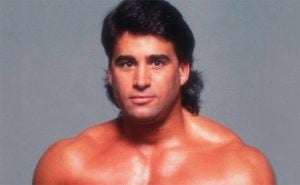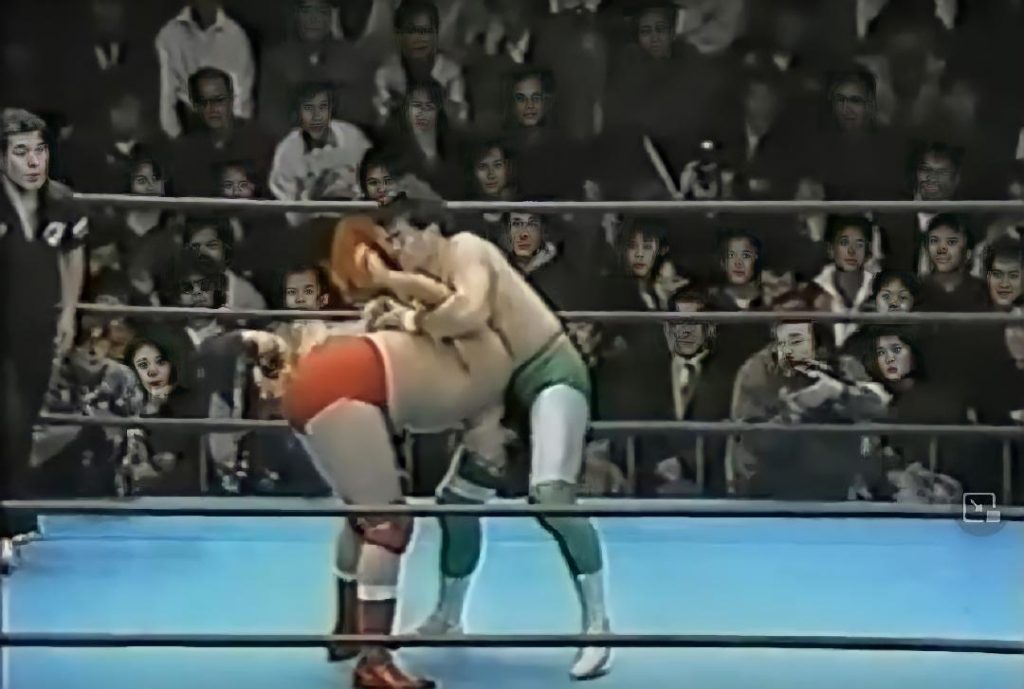Misawa debuts Tiger Driver 91. Some fans don’t like seeing wrestling but just want to see wrestling moves. They don’t care about angles, stories, subtleties, or background; they just want to see crazy moves. And few wrestlers are more famous in this day and age for crazy moves than Mitsuharu Misawa.
Although his career has long come and gone, he is still known today for crazy wrestling moves, both as someone that delivered them and as someone who took them.
We’ve already seen two notable examples of Misawa taking wrestling moves; he was the poor soul who suffered the debut of both Toshiaki Kawada’s dreaded Ganso Bomb and Kenta Kobashi’s legendary burning Hammer. But now it’s time for Misawa to get his spotlight as the guy dishing out the violence.
On January 26th, 19991, was the All Japan debut, of Mitsuharu Misawa’s Tiger Driver ’91.

Misawa debuts Tiger Driver 91
A Point of Clarity.
Before we delve into Misawa’s use of the Tiger Driver ’91, it’s important to note the move’s history. Even though it’s widely called the Tiger Driver ’91, Misawa did not invent the move itself. It is the double underhook kneeling spike powerbomb.
That move was created years earlier by a women’s wrestler named Jaguar Yokota. Yokota used it during her run in All Japan Women’s Pro-Wrestling (AJW).
However, since Misawa and All Japan Pro-Wrestling (AJPW, which is unaffiliated with AJW) had wider popular appeal and reach, he is widely considered the man to popularize the move.
For the sake of balance and fairness, we’re not going to argue who created or popularized what here. Instead, we’re looking at the times Misawa used the move during his All Japan and NOAH careers and what it meant to his matches and legacy.
King’s Road: Building upon the limits you set in the last
Misawa’s wrestling prime was in AJPW during its 1990s golden age. That period was so great for many reasons. It was one of the big ones being how the matches featured logical progression.
Matches didn’t exist in a vacuum but were smaller pieces in a larger tapestry. The in-ring stories between wrestlers spanned years, which made call-backs to previous matches so important.
That logic is the foundation on which the Tiger Driver ’91 was built. Misawa had several regular finishers, one of which was a standard Tiger Driver (double-underhook powerbomb).
He won with this move a lot, and as time wore on, it was expected to lose its effectiveness. Especially since his defeated opponents would learn of the move and either find counters to it or train themselves with fight through it and kick out.
Thus, Misawa needed something for special occasions. He needed to make his opponents believe they were going to take a standard Tiger Driver, only for Misawa to pull off a last-second surprise. And in keeping with the spirit of the times, he decided the best thing to do was to spike them on their necks.
In a way, Misawa and this King’s Road structure of building on top of things is the pro-wrestling version of Dragon Ball. Let’s assume Misawa is Goku for a moment.
Early on in his story, Goku won his biggest fights with the Kamehameha, which is presented as his ultimate technique. As time goes on, Goku found himself dealing with two problems.
New opponents were too strong for him to finish with the Kamehameha, and people he has faced in the past have learned to deal with it as well, so it no longer worked on them, either.
Thus, Goku was forced to adopt new techniques that were built on top of the damage he did with the Kamehameha. Eventually, he either creates a stronger version of the Kamehameha, and as an alternate weapon, he has the Spirit Bomb.
Misawa’s Tiger Driver ’91 could be considered the pro-wrestling version of this progression. Misawa spent years beating wrestlers with a standard Tiger Driver finisher. But when wrestlers started kicking out of that move, Misawa had to rely on other moves to win as well: his Tiger Suplex, various elbow smashes, a top-rope frog splash, and so on.
But when all of those moves failed as well, Misawa had no choice but to dig down deep and bring out his ultimate weapon.
The Move makes its debut.
On January 26th, 1991, Misawa debuted the Tiger Driver ’91 in a match against Akira Taue. Landing this move here served two purposes. First, it established Misawa’s new super-finisher and showed he had a new trick up his sleeve.
Second, Misawa got a measure of revenge against Taue, who betrayed him months earlier and aligned himself with Misawa’s archrival, Jumbo Tsuruta.
And so began Misawa’s streak of spiking people on their heads.

Like Kobashi’s fabled Burning Hammer, Misawa only brought out the TD’91 on rare occasions. He saved it for only his most challenging of opponents or for the most serious of matches. Taue was the first to fall, and then a few months later, Misawa busted it out on one of his tag partners, Kobashi.
Not out of malice or anger, but because Kobashi was proving to be so defiant and determined that Misawa needed to put him in his place (this wouldn’t be the last time Kobashi would take this move).
Misawa’s third TD’91 took place years later in a singles match against ‘Dr. Death’ Steve Williams. This one was especially shocking because of how much bigger Doc was.
He was nearly 300 pounds, and Misawa dropped him on his head, neck, and upper shoulders with all of Doc’s weight folding over top of him. Then again, it made sense for Misawa to use this move because Doc was such a dangerous force in All Japan at the time.

The next one is quite possibly the most iconic of Misawa’s TD’91s. It took place in that legendary match between Misawa and his new archrival Toshiaki Kawada. It was on June 3rd, 1994, in quite possibly the best match to ever take place.
Misawa and Kawada fought in a genuine classic for almost 36 minutes, and the match was punctuated with an absolutely brutal head spike. To this day, many fans wonder how Kawada wasn’t paralyzed or killed by that move, regardless of whatever safeguards Misawa had to ensure he wasn’t risking Kawada’s life.

Misawa debuts Tiger Driver 91 – A Story within a Story.
By 1995, the TD’91 had become established as Misawa’s ultimate weapon, and everyone that took it stayed down for the three-count. But there was one wrestler that.
Kobashi, like Kawada before him, wanted to break out of Misawa’s shadow and become a singles star. To make people believe he could succeed away from Misawa, he needed to show once again that he could take whatever Misawa threw at him and keep going.
On October 25th, 1995, he got his first chance. In another near-40-minute match, Kobashi fought Misawa with all his might, only to lose to Misawa’s TD’91.
History repeated itself, but it was for the last time.
Over a year passed between this match and the next time Misawa released his ultimate finisher. The next one took place on January 20th, 1997, in another match widely considered to be one of the best ever.
This one was the inverse of the 10/25/95 match; Kobashi was the champion defending against Misawa. Having been more familiar with Misawa’s wrestling style than anyone else, Kobashi went into this defense with a strategy.
He wanted to weaken Misawa’s arm so that Misawa couldn’t land any of his biggest moves. His strategy wasn’t entirely successful; despite some incredible wrestling, Misawa was still able to drop Kobashi with a running elbow smash and win the Triple Crown Heavyweight Championship.
But something big happened before that: Kobashi was kicked out of the Tiger Driver ’91. After almost six full years, someone finally kicked out of Misawa’s super finisher.

Ten months later, Kobashi tried to get his revenge, but this time his strength failed him sooner. This time the TD’91 was successful, and Misawa retained against his worthy challenger.
That sent the message that Kobashi kicking out was a fluke and that the TD’91 was still Misawa’s ultimate super-weapon. This was proven once again on February 28th, 1998, when Misawa used it to put Johnny Ace out to retain his world title again.
Yes, Johnny Ace once took a Tiger Driver ’91.

A fluke no more
On October 31st, 1998, Misawa and Kobashi had a rematch from their 1/20/97 encounter. Whereas the first match was all about Kobashi’s arm-targeting strategy, this match was all about the two wrestlers throwing bombs and wearing each other out.
Yet there was one moment that was the same as before: Kobashi kicked out of the TD’91 for the second time.
Kobashi had fully established himself as this runaway freight train that just wouldn’t stop until he got knocked out, which is what Misawa was forced to do. He hit Kobashi with a devastating one-two combo that knocked Kobashi out cold, knowing it was all that he could do since his TD’91 was no longer effective.
The same thing happened eight months later, in June 1999, when they faced each other again. Like before, Kobashi withstood an ungodly amount of punishment, yet he still managed to kick out of the Tiger Driver ’91.
But unlike before, a random elbow wasn’t enough to keep him down. This time, Misawa had to go even further than before with the super-finishers and drilled Kobashi with his new never-kicked-out-of Emerald Flowsion.
The result was the same: Kobashi had come even closer to winning but still lost in a valiant effort.
Final appearances
Misawa kept the TD’91 for special occasions, even as the most lost its effectiveness. He realized that it made more sense to use his Emerald Flowsion in its place since that move was newer and (thus far) more effective at ending his matches. But the TD’91 did make some notable final appearances.
A month after the June Kobashi challenge, Misawa busted out the TD’91 on Kawada. What happened in this match really underscored how brutal this move was, even after all this time.
Misawa didn’t pin Kawada right after hitting the move; his matches with Kobashi had convinced him that it was no longer enough. But as he prepared to charge for an elbow smash, the referee came up to him and told him not to and to just pin Kawada.
The ref saw that Kawada was out cold, and they’d be waiting forever for Kawada to get up. Such was the awesome power of Misawa’s Tiger Driver ’91.
It would be many years before this vicious move would be seen again. Misawa spent most of the early 2000s winning matches with the Emerald Flowsion, to the point that the TD’91 was almost forgotten, save for some entries in WWE’s early video games.
It sort of made a return on March 1st, 2003, in Misawa’s final big singles match with Kobashi. I say ‘sort of’ because the move was only teased and not landed fully.
Kobashi had kicked out of the Emerald Flowsion (becoming the first person to do so). This forced Misawa to try what had, by that point, become an old trick. But Kobashi wouldn’t let history repeat itself and escaped Misawa’s grasp before that move could ever connect.
The final three TD’91s weren’t as visually impressive as the earlier ones (none will ever top Misawa spiking Kawada on 6-3-94 with it), but they were still historically significant. The next one was on July 18th, 2004, in Misawa’s first match with AJPW post-split.
No one thought Misawa would ever come back to All Japan following the split. But there he was, wrestling against the company’s new ace, Satoshi Kojima. Kojima did all he could, but he couldn’t withstand Misawa’s deadly finisher and took the fall.
Misawa debuts Tiger Driver 91.
The next one was on July 18th, 2005, in Misawa’s last-ever match with Kawada. Kawada had stayed with All Japan in the split, and politics made inter-promotional cooperation impossible up until that point.
Though both of them were way past their primes, they both agreed that their feud needed to come to a fitting end. To do that, they both busted out their biggest moves on each other, which included Misawa hitting the TD’91.
Kawada kicked out this time. But that move still hurt him so much that he was still felled by one of Misawa’s trademark elbow smashes.
Finally, there was Misawa’s TD’91 to his protégé Naomichi Marufuji on December 10th, 2006. Marufuji was a world champion and needed to prove he was, at the very least, as tough as his mentor. He proved that when he kicked out of the TD’91, but he still lost the match not long after taking that brutal move.
Misawa debuts Tiger Driver 91.
Although Misawa didn’t create this move, he’s its most famous user, and he has carved quite a legacy with it. It has been an integral part of his biggest matches and deepest stories.
He has used it to put many wrestlers away and make others into even tougher fighters. Sometimes a move is more than just a move; with the right story, a single move can make or break a wrestler. Such was the case with Misawa’s take on the Tiger Driver ’91.







